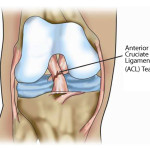ACL Tear Rehab – Physio Corner

July 11, 2013- Oakville Soccer League – We had just won a corner kick. The ball was whipped in and I went to head it when another girl pushed me mid-air. When I landed I felt a tearing sensation across my knee and a loud pop. An MRI confirmed: ACL (anterior cruciate ligament) rupture and torn meniscus. After countless doctors’ appointments and surgical consults, I was scheduled to undergo ACL reconstruction 3 months later.
Background
Over a quarter of a million ACL injuries occur every year in Canada and the United States (AAOS 2014). The ACL is 1 of 4 major ligaments in the knee that primarily prevents forward movement of the tibia relative to the femur. ACL injuries are most commonly due to sudden changes in direction, quick decelerations and awkward landing patterns and can be due to both contact or non-contacts sports.
Surgery vs No surgery
Studies have looked at the impact of conservative non-surgical interventions following ACL ruptures and found that there was limited evidence to support conservative protocols and that these patients may not be spared from future surgery (AAOS 2014).
In most cases, for young athletes that have experienced an ACL rupture, surgery is recommended if they would like to return to prior injury status.

What graft should I choose?
The ACL is typically reconstructed via:
- An autograft (using a donor site from the patient, most commonly the patellar tendon or hamstring tendon) or
- An allograft (using a cadaver’s tendon).
The American Academy of Orthopaedic Surgeons (AAOS) reports there was a higher failure rate of allograft reconstructions in younger patients. Furthermore, they concluded that both the patellar and hamstring autograft had similar outcomes regarding stability testing, patient satisfaction, subjective scores and graft failure. Note that the type or surgery is dependent on the surgeon, but also patient preference/ characteristics. In my case I opted for the patellar tendon graft.
Prehab
Current evidence recommends that physiotherapy be performed prior to surgery to increase/ maintain full range of motion (ROM), minimize joint swelling, increase strength and balance and decrease the number of “giving way” instability episodes (Fowler Kennedy).
Post-Op Rehab
Once surgery is complete, the athlete will often follow a surgical protocol with an estimated return to play anywhere from 6 months to over a year. Currently there is moderate evidence to support the use of early, accelerated AND non-accelerated protocols as both have similar outcomes (AAOS, 2014).
Accelerated rehab is generally associated with early:
- Weight bearing (immediately)
- Non-restricted ROM and
- Strengthening (first 3 weeks).
Future blog posts will look at the difference between the two protocols.
Return to Sport
Return to sport is generally initiated around the 9-12 month mark on the condition that there is no pain or swelling during functional activities and/or sport specific drills. The athlete must also demonstrate adequate balance, strength and endurance specific to the required sport (Fowler Kennedy). I would also add that the athlete has to be psychologically ready to engage in sports again. Whether that’s cutting, pivoting, going into tackles 100% or doing the very thing that lead you to surgery in the first place: heading the ball again with contact, the athlete must be 100% committed. Physically I had met all the milestones: symmetrical leg strength, balance, power, etc… But my first game. My first tackle. I let the girl have the ball. It took me one full season to gain my confidence back. Take it slow. Don’t expect to be the player you were the day of your injury. It takes time.
To Brace or not to Brace?
Bracing is often at the surgeon and patient’s discretion. Current research does not support the use of a brace to prevent re-injury, however, it does improve proprioceptive/ balance measures (Fowler Kennedy). Personally, I found my custom Donjoy to be too heavy and actually gave me secondary lower leg issues (compartment syndrome). I now use a neoprene Donjoy with no issues, mainly for proprioception and psychological support.
So would I change those 15 months? Absolutely not. This experience has given me a whole new perspective and great insight into the medical pathways, operative procedures and rehab process. I will truthfully say that before this injury, I was a therapist that pushed for objective measurements- meeting timelines, making range, pushing for early return to sport. After this injury, I’ve come to appreciate that I am treating a PERSON rather than a knee.
Finally, here are my tips/tricks to ACL rehab:
- Don’t be a hero-Control your pain in the early stages (cryocuff/ compression/ pain meds)
- Be diligent in your rehab (pre and post surgery) and commit to it. It’s a long process!
- Set small goals! Don’t focus on the fact you can’t play sports right now
- Take your time, not everything is about following the protocol. Listen to your body.
- Warm up before your recreational games!
Part 2 will focus on how to prevent ACL ruptures and the current literature to support the use of a specific warm up called the FIFA 11+
References
(1) Management of Anterior Cruciate Ligament Injuries: Evidence-Based Clinical Practice Guideline (2014). Rosemont, IL: American Academy of Orthopaedic Surgeons.
(2) Physiotherapy following ACL Reconstruction Protocol. Fowler Kennedy (http://fowlerkennedy.com/wp-content/uploads/2015/11/PHYSIOTHERAPY-FOLLOWING-ACL-RECONSTRUCTION-PROTOCOL-November-2015.pdf
